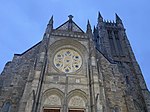Taft Tunnel
1837 establishments in ConnecticutLisbon, ConnecticutRailroad tunnels in ConnecticutTransportation buildings and structures in New London County, ConnecticutTunnels completed in 1837

Taft Tunnel is a railroad tunnel in the northeast United States, located in the southwest part of Lisbon, Connecticut. Completed in 1837, it was the first common carrier railroad tunnel built in the United States, though it was not used until 1839 (before which several other tunnels were in use). It is still in use in its original form.
Excerpt from the Wikipedia article Taft Tunnel (License: CC BY-SA 3.0, Authors, Images).Taft Tunnel
River Road,
Geographical coordinates (GPS) Address Nearby Places Show on map
Geographical coordinates (GPS)
| Latitude | Longitude |
|---|---|
| N 41.5544 ° | E -72.036 ° |
Address
River Road 634
06351
Connecticut, United States
Open on Google Maps










